ELITEGROUP COMPUTER SYSTEMS EF2BC40EA3 Notebook User Manual Draft EF20EA UM 20150907
ELITEGROUP COMPUTER SYSTEMS CO., LTD Notebook Draft EF20EA UM 20150907
Users Manual

User Guide
For
Laptop EF20EA
Regulatory Compliance
Information
FCC Declaration of Conformity
This device complies with Part 15 of the FCC Rules. Operation is
subject to the following two conditions: (1) this device may not cause
harmful interference, and (2) this device must accept any
interference received, including interference that may cause
undesired operation.
This equipment has been tested and found to comply with the limits
for a Class B digital device, pursuant to part 15 of the FCC Rules.
These limits are designed to provide reasonable protection against
harmful interference in a residential installation. This equipment
generates, uses and can radiate radio frequency energy and, if not
installed and used in accordance with the instructions, may cause
harmful interference to radio communications. However, there is no
guarantee that interference will not occur in a particular installation.
If this equipment does cause harmful interference to radio or
television reception, which can be determined by turning the
equipment off and on, the user is encouraged to try to correct the
interference by one or more of the following measures:
Reorient or relocate the receiving antenna.
Increase the separation between the equipment and receiver.
Connect the equipment into an outlet on a circuit different
from that to which the receiver is connected.
Consult the dealer or an experienced radio/TV technician for
help.
RF exposure warning
This equipment must be installed and operated in accordance with
provided instructions and the antenna(s) used for this transmitter must be
installed to provide a separation distance of at least 20 cm from all
persons and must not be co-located or operating in conjunction with any
other antenna or transmitter. End-users and installers must be provide
with antenna installation instructions and transmitter operating conditions
for satisfying RF exposure compliance.

CAUTION:
Any changes or modifications not expressly approved by the grantee of
this device could void the user's authority to operate the equipment.
For questions related to the EMC performance of this product,
contact:
Elitegroup Computer Systems Co., Ltd
No.239, Sec. 2, Ti Ding Blvd., Taipei, Taiwan 11493
886-2162-1177
Canadian Department of Communications Compliance
Statement
This digital apparatus does not exceed the Class B limits for radio
noise emissions from digital apparatus set out in the Radio
Interference Regulations of the Canadian Department of
Communications. This device complies with Industry Canada
licence-exempt RSS standard(s). Operation is subject to the
following two conditions: (1) this device may not cause interference,
and (2) this device must accept any interference, including
interference that may cause undesired operation of the device.
Le présent appareil numerique német pas de bruits radio
électriques dépassant les limites applicables aux appareils
numériques de la classe B prescrites dans le Réglement sur le
broullage radioélectrique édicté par le ministére des
Communications du Canada. Le présent appareil est conforme aux
CNR d’Industrie Canada applicables aux appareils radio exempts
de licence. L’exploitation est autorisée aux deux conditions
suivantes : (1) l’appareil ne doit pas produire de brouillage, et (2)
l’utilisateur de l’appareil doit accepter tout brouillage radioélectrique
subi, même si le brouillage est susceptible d’en compromettre le
fonctionnement.
CE mark. Declaring compliance to all the applicable
European Union (EU) directives. For CE mark related
questions:
Elitegroup Computer Systems Co., Ltd
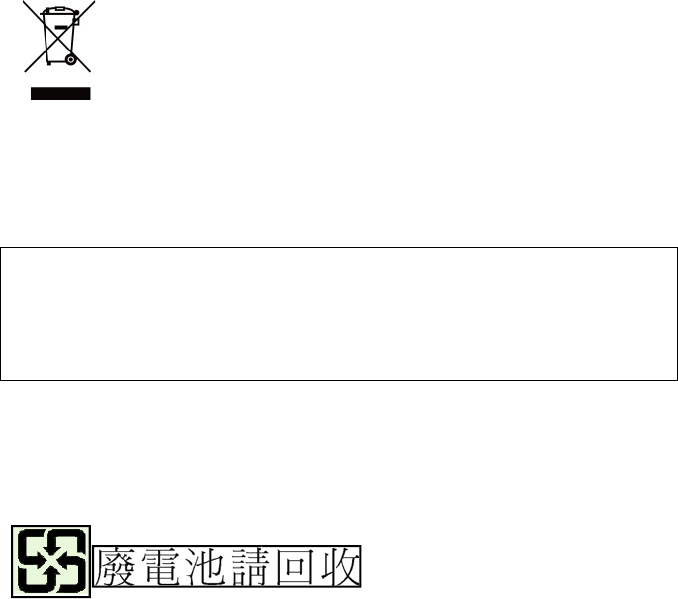
Fr
e
Vot
rad
ww
w
Ja
p
に
基
と
を
し
て
Tai
w
Tra
No.2
3
886-
2
e
nch SAR
/
re ordinat
e
iofréquen
c
w
.radiofre
q
In
t
thi
s
of
w
ha
n
re
c
eq
u
yo
u
pu
r
p
an VCCI
S
この装置は
基
づくクラス
を
目的として
い
て
使用される
取扱説明書
w
an batt
e
nslation –
3
9, Sec. 2,
2
162-1177
/
DAS
e
ur a un D
A
c
es-sante-
e
q
uences.g
t
he Europ
e
s
product i
n
w
ith hous
e
n
d it over t
o
c
ycling of
w
u
ipment. F
u
r local wa
r
chase of t
S
tatemen
t
、情報処理
装
B情報技術
装
い
ますが、
こ
と、受信障
害
に従って正
し
e
ry recycli
please re
c
Ti Ding B
l
A
S. Pour
p
e
nvironne
m
ouv.f
r
e
an Union,
n
cluding b
a
e
hold wast
e
o
a desig
n
w
aste elec
t
or more in
ste collect
his produ
c
t
装
置等電波障
害
装
置です。こ
こ
の装置がラ
害
を引き起こ
し
い取り扱
い
ng:
c
ycle batte
l
vd., Taipe
i
p
lus d'info
r
m
ent:
this symb
a
ttery mu
s
e
. It is you
r
n
ated colle
c
t
rical and
e
formation,
ion center
c
t.
害
自主規制
協
の装置は、
家
ジオやテレ
ビ
すことがあ
い
をして下さ
い
ries
i
, Taiwan 1
r
mations,
v
ol indicate
s
t not be di
r
responsi
b
c
tion point
e
lectronic
please c
o
or the poi
n
協
議会 (VCC
I
家
庭環境で
使
ビ
ジョン受
信
ります。
い
。
1493
v
oir le port
a
s that
sposed
b
ility to
for the
o
ntact
n
t of
I
) の基準
使
用するこ
信
機に近接
a
il
經型式認證合格之低功率射頻電機,非經許可,公司、商號或使用
者均不得擅自變更頻率、加大功率或變更原設計之特性及功能。
低功率射頻電機之使用不得影響飛航安全及干擾合法通信;經發現
有干擾現象時,應立即停用,並改善至無干擾時方得繼續使用。
前項合法通信,指依電信法規定作業之無線電通信。低功率射頻電
機須忍受合法通信或工業、科學及醫療用電波輻射性電機設備之干
擾。
在5.25 ~ 5.35GHz 頻帶內操作之無線資訊傳輸設備,限於室內使用'
*使用過度恐傷害視力。
*使用30分鐘請休息10分鐘。
2歲以下幼兒不看螢幕, 2歲以上每天看螢幕不要超過1小時

Attention: Teachers, Parents and Adult
Supervisors
This product is an educational tool designed for school children,
ages 6 and up. There must be supervision by an adult on school
children under 10 when using this laptop. It is a must to have a
thorough explanation to students on safe and proper handling of
the laptop, power supply, battery pack, and power cord.
Be sure to keep the power cord away from
younger children
Please ensure that students understand the following:
As with all electrical products, precautions should be observed during
handling and use to prevent electric shock. The power supply
(adapter) should not be handled by the children.”
Emphasize to students that this device is an educational tool and not
a toy. The computer, power supply, battery pack or power cord should
not be dropped, crushed, stepped on or otherwise abused.
Ensure students understand the safe and proper handling of power
cord and power supply. Misuse could result in serious injury.
The teacher, parent or adult supervisor should periodically inspect the
computer; power supply and power cord for damage and replace it, if
necessary.
Students should report any damage or loose parts to their teacher,
parent or adult supervisor, immediately.
Do not leave the PC plugged in or “on” when enclosed in a non-vented
container, such as a school backpack, as overheating may occur.
It is recommended that students should take a 5 minute break every
30 minutes of use.
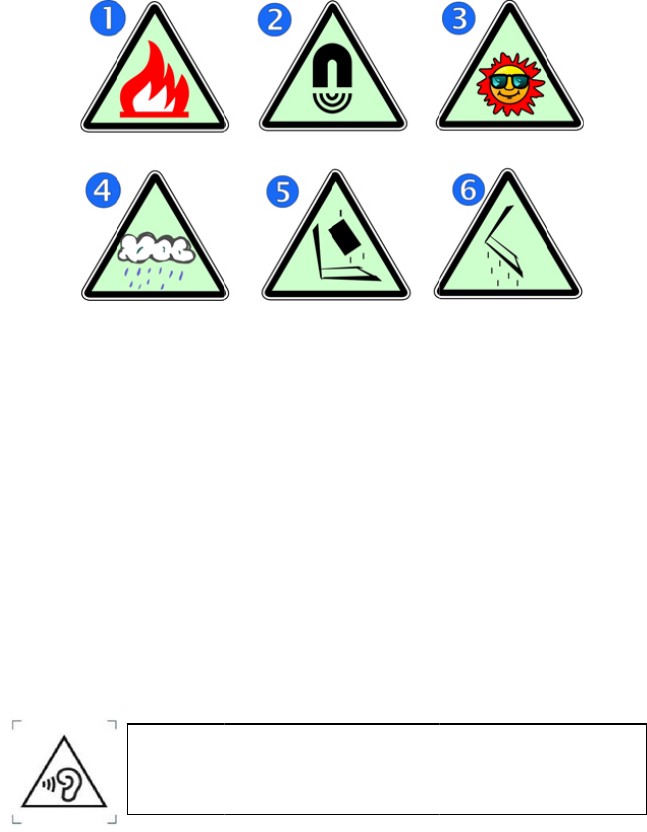
Th
e
un
d
ho
m
RIS
K
DIS
P
RIS
Q
INC
INS
T
IT I
S
WH
e
following
d
erstand b
e
m
e enviro
n
1. Do
n
2. Do
n
3. Do
n
4. Do
n
5. Do
n
co
m
6. Do
n
K
OF EXPL
O
P
OSE OF U
Q
UE D'EXP
L
ORRECT. R
T
RUCTION
S
S
RECOMM
E
ERE THE A
M
are lists o
f
e
fore usin
g
n
ment:
n
ot place
n
n
ot expos
e
n
ot expos
e
n
ot expos
e
n
ot place
h
m
puter.
n
ot drop th
O
SION IF B
A
SED BATT
E
L
OSION SI
L
ECYCLEZ
L
S
.
E
NDED TO
U
M
BIENT TE
M
TO PRE
V
NOT LIS
T
PERIOD
S
f
precauti
o
g
this com
p
n
ear the fir
e
e
to magne
t
e
to direct s
e
to rain or
m
h
eavy obje
c
e compute
A
TTERY IS
R
E
RIES ACC
O
L
A BATTERI
L
ES BATTE
R
U
SE THIS
C
M
PERATUR
E
V
ENT POSS
T
EN AT HIG
H
S
.
Sa
o
nary mea
s
p
uter insid
e
or other s
t
ic fields.
unlight.
m
oisture.
c
ts to add
h
r.
R
EPLACED
B
O
RDING TO
T
E EST REM
R
IES USAG
É
C
OMPUTER
E
IS NO MO
IBLE HEARI
H
VOLUME
fety Pr
e
s
ures the
s
e the clas
s
ources of
h
h
eavy pres
s
C
B
Y AN INC
O
T
HE INSTR
U
AT
PLACÉE P
A
É
ES SELON
IN AN ENVI
R
RE THAN 3
5
NG DAMA
G
LEVELS F
O
e
cautio
n
s
tudents m
s
room or
h
eat.
s
ure on th
e
C
AUTI
O
O
RRECT TY
P
U
CTIONS.
T
TENTI
O
A
R UN TYP
E
LES
R
ONMENT
5
°C.
G
E, DO
O
R LONG
n
s
ust
e
O
N
P
E.
O
N
E

Contents
1. Getting to know your computer.................................................1
Package contents..............................................................................................................1
Layout......................................................................................................................................2
Views............................................................................................................................2
Front..........................................................................................2
Right..........................................................................................3
Left.............................................................................................3
Back...........................................................................................4
Function keys...........................................................................................................5
2. Using your computer..................................................................6
Powering ON/OFF............................................................................................................6
Powering on your computer.............................................................................6
Powering on for the first time..........................................................................6
Powering off your computer.............................................................................7
Putting your computer into sleep mode.....................................................8
Waking up your computer.................................................................................9
Basic touchpad operations...........................................................................................9
3. Windows Interface.........................................................................10
Desktop and virtual desktop experience.............................................................10
Taskbar.................................................................................................................................11
Start menu...............................................................................................................11
Search box - Cortana........................................................................................12
App shortcuts area..............................................................................................13
Notification area...................................................................................................13
4. Setup and Connection.................................................................14
Settings screen.................................................................................................................14
Windows Activation........................................................................................................15
Setup Your Microsoft Account...................................................................................15
Replacing Desktop with Start screen....................................................................16
Pin and unpin your app................................................................................................17
Pinning an App to Start menu or taskbar................................................17
Removing an App................................................................................................17
Wireless LAN.....................................................................................................................18
Enabling wireless connection........................................................................18
Connecting to a wireless LAN.......................................................................18
Micro SD Card Slot.........................................................................................................19
To insert your micro SD card.........................................................................19
To remove your memory card.......................................................................20
Connecting an External Device...............................................................................20
Connecting to the USB port...........................................................................20
Connecting to the HDMI port.........................................................................21
5. Battery................................................................................................22
Charging your battery....................................................................................................22
Inspecting your battery status...................................................................................23
By inspecting the taskbar................................................................................23
By inspecting the battery indicator.............................................................24
6. Windows Help and Troubleshooting.....................................25
Settings for Sleep mode..............................................................................................25
Troubleshooting................................................................................................................26
7. Specification....................................................................................31
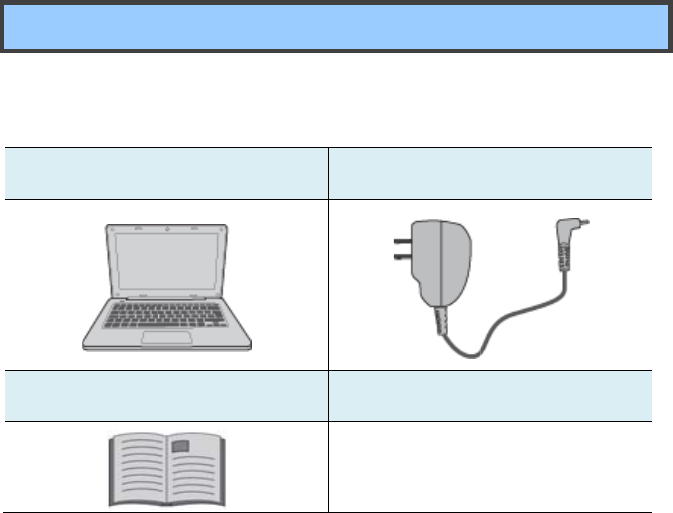
Pa
Car
e
of t
h
1.
G
ckage c
o
e
fully unpac
k
h
e items is
m
• On
e
• This
G
etti
n
o
ntents
k
your box a
n
m
issing or da
m
e
laptop
manual
1
n
g t
o
n
d take out
t
m
aged, con
t
o
kn
o
co
t
he items list
e
t
act your de
a
• One
A
o
w y
o
mpu
e
d as below
.
a
ler immedia
t
A
C adapter
o
ur
ter
.
If any
t
ely:
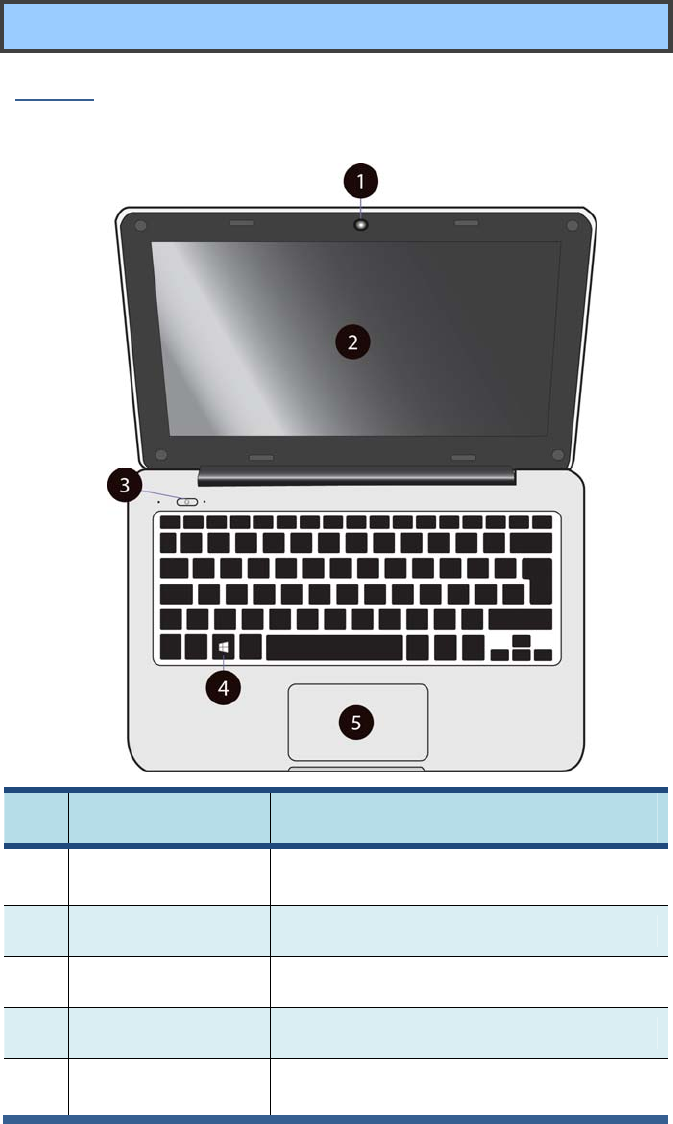
2
Layout
Views
Front
No. Name Function
1 Front facing camera Often for taking self-portraits as well as for
video conferencing.
2 LCD screen The main display of your laptop
3 Power button Power on/off your laptop.
4 Windows key Press here to open the Start menu.
5 Touchpad Allows you to control your system using
figure gestures.
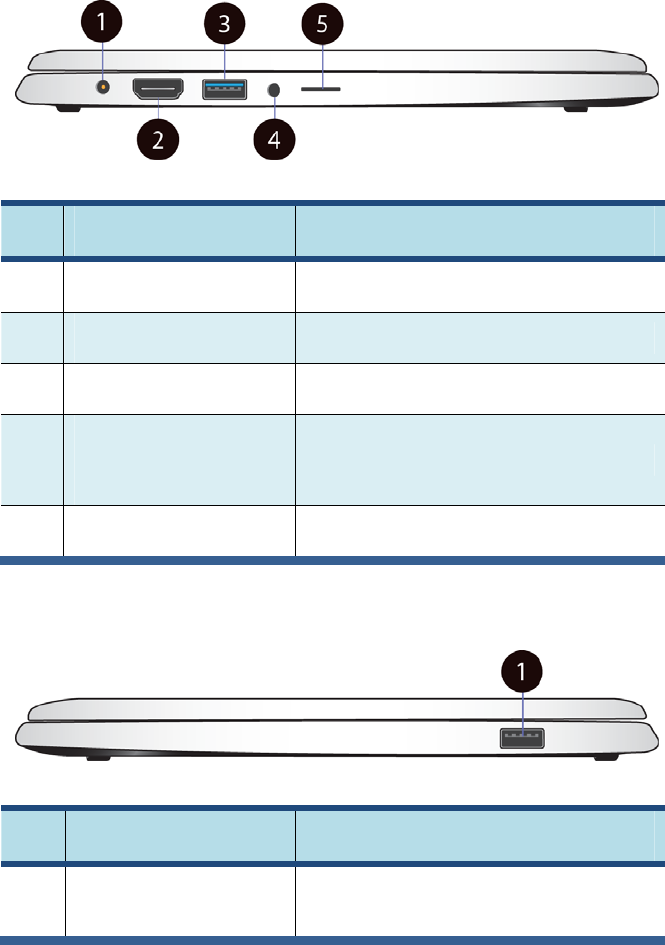
3
Right
No. Name Function
1 DC-in
Plug the adapter to charge the battery.
2 HDMI port Plug your HDMI-capable monitor here.
3 USB 3.0 port Plug your USB devices here.
4 Combo Audio jack for
microphone/headphone
Plug your 3.5mm headphone here.
5 Micro SD card slot Plug your micro SD card here
Left
No. Name Function
1 USB 2.0 port Plug your USB devices here.
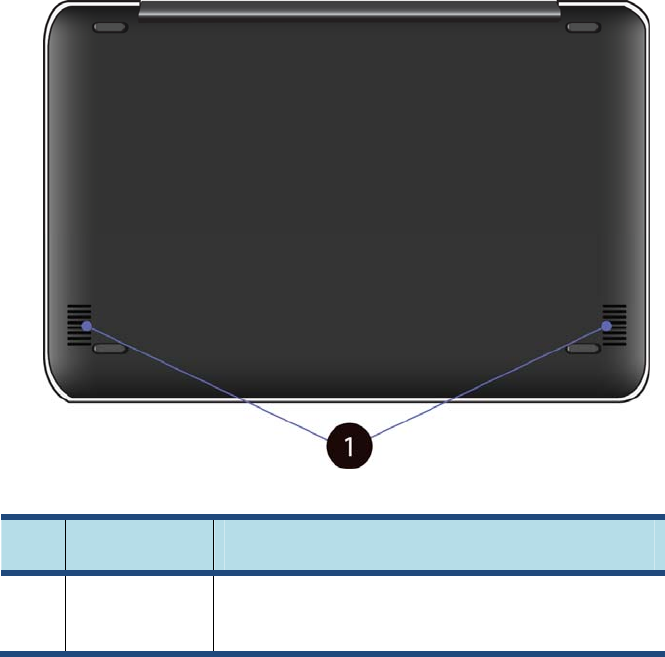
4
Back
No. Name Function
1 Speaker
The sound system has two speakers for playing
music, notification sounds, and other audio data.
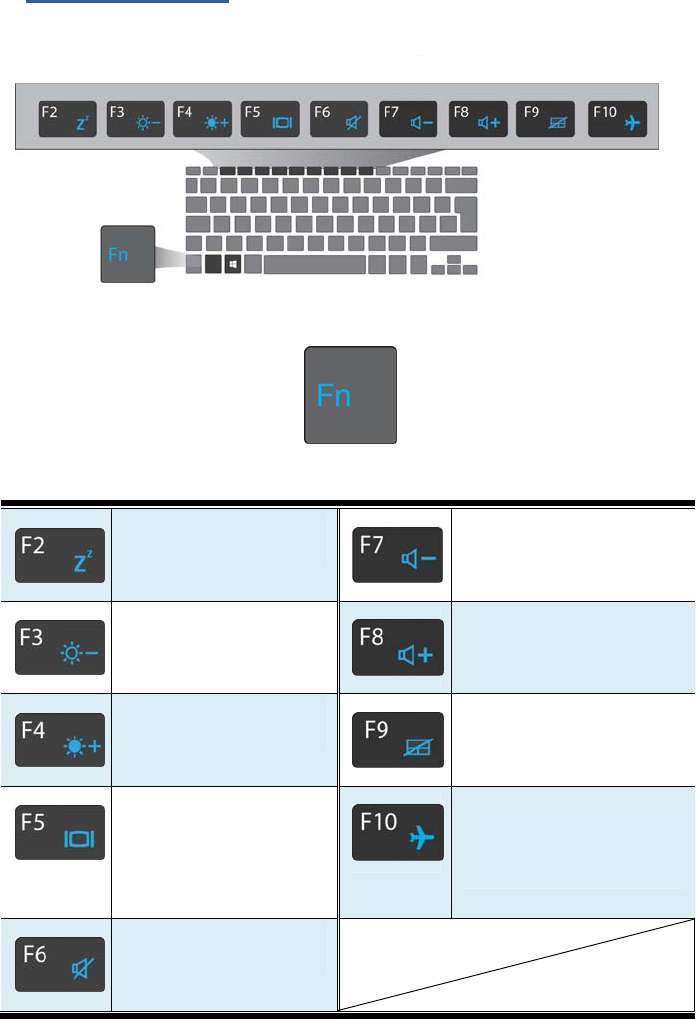
5
Function keys
+
Puts your computer
into sleep mode.
Decreases the volume
level.
Decreases the display
brightness.
Increases the volume
level
Increases the display
brightness.
Disables or enables the
touchpad.
Switches display
output between your
display, external
monitor (if connected)
and both.
Enables or disables the
airplane mode by
stopping all wireless
features
Mutes/unmutes the
audio output.
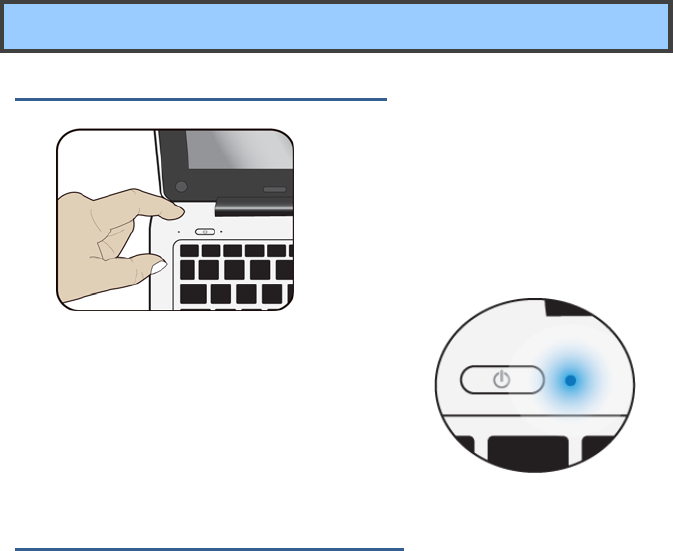
6
2. Using your
computer
Powering ON/OFF
Powering on your computer
1. If this is the first time you turn
this computer on, connect the
AC adapter and fully charge the
battery.
2. Press the power button (normally 1 to
2 seconds) until you see the power
indicator lights up in blue.
Powering on for the first time
The laptop will require you to do the initial setup, which including:
Activate your Windows 10
Sign in to or create your Microsoft account
Setup a wireless connection and more
Please follow the instruction to complete the initial setup.
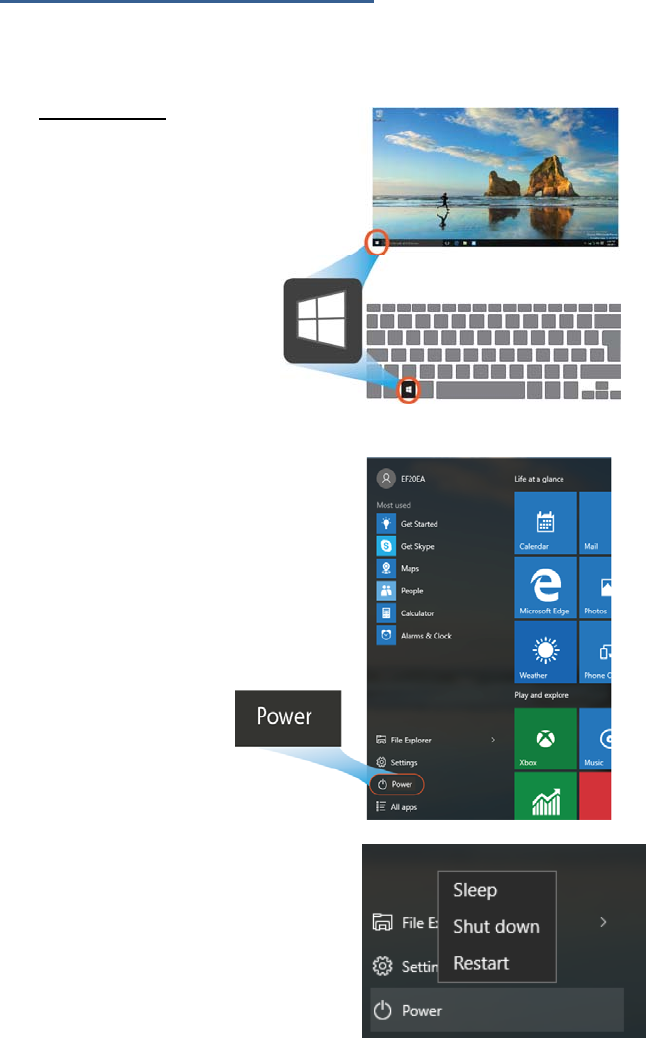
7
Powering off your computer
Save all your data before powering your computer off.
To power off your system, following the steps below:
A. By Start menu
1. Click the Windows icon
in the low-left corner of
the Desktop. Or, press
on the Windows key in
the keyboard.
2. In the Start menu, click
<Power> option, as shown on
the right,
3. Select <Shut down> from the
power option menu, as shown on
the right.
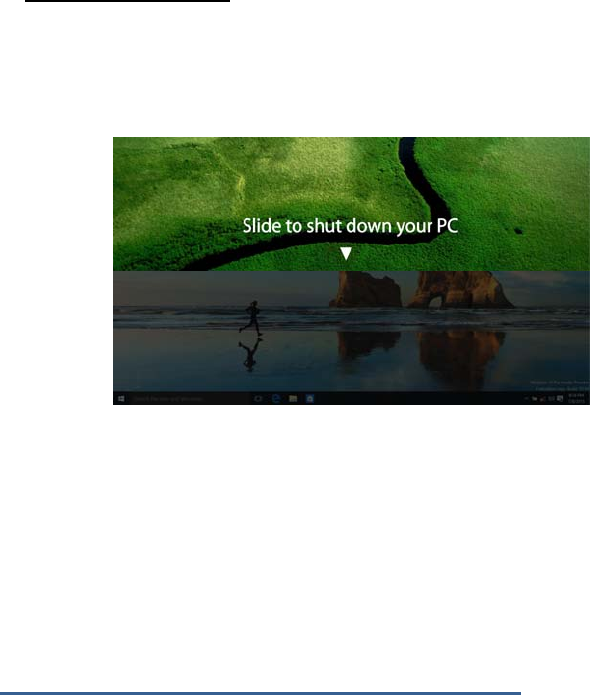
8
B. Using the power button
Press and hold the power button for at least four seconds, and you
will see an instruction appear in the middle of the screen, which is as
shown below.
Drag the upper image downward to the bottom of the screen or simply
press the spacebar of the keyboard, and the system will power off
itself.
In here, if you don’t want to power off your system, just press any key
(but not the spacebar) on the keyboard.
Putting your computer into sleep mode
When you will be away from your computer for a short time, put the
computer to sleep.
Do one of the following:
• Close the display panel
• Press Fn + F1.
• Press the power button briefly one time.
• Open the Start menu and then select <Power> → <Sleep>.
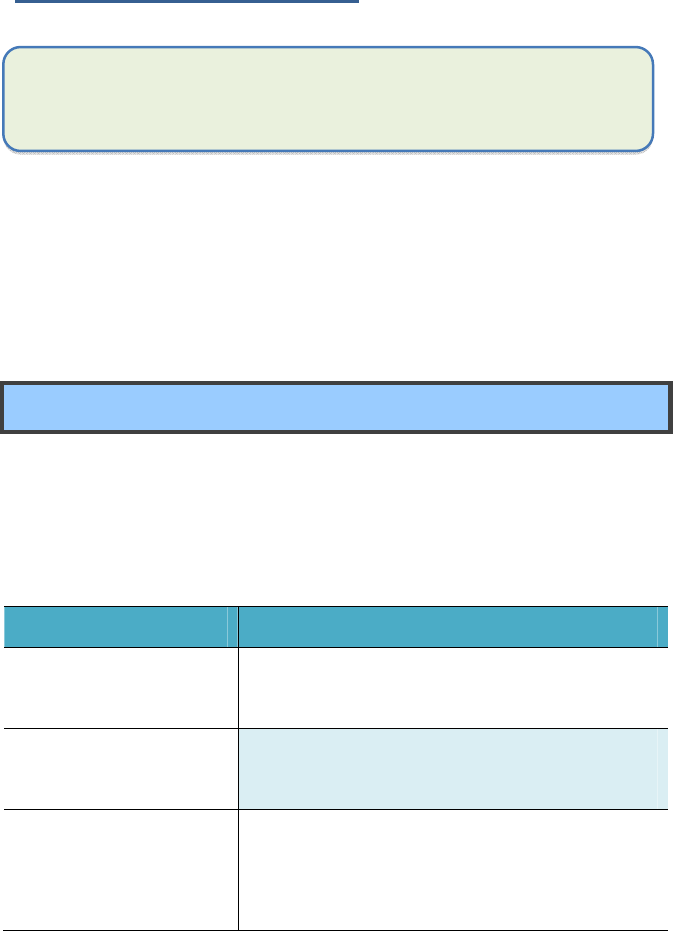
9
Waking up your computer
Note: It is recommended that you put your computer to sleep before
you move it. Moving your computer while the hard disk is spinning
can sometimes damage the hard disk, causing loss of data.
Do one of the following:
A: Pressing the power button briefly one time.
B: Pressingany key on the keyboard, tapping the touchpad, or opening
the display panel.
Basic touchpad operations
The touchpad works like a traditional mouse. With it, you can move the
cursor and perform left-click, right-click, double-click actions. However,
the actual available actions are application dependent.
Action name Explanation
Left-clicking (or
Clicking)
Tap once on the touchpad surface or press
once on the low-left corner of the touchpad.
Right-clicking Press once on the low-right corner of the
touchpad.
Dragging Press and continue to hold down the left
corner and then move (drag) your finger
across the touchpad surface.
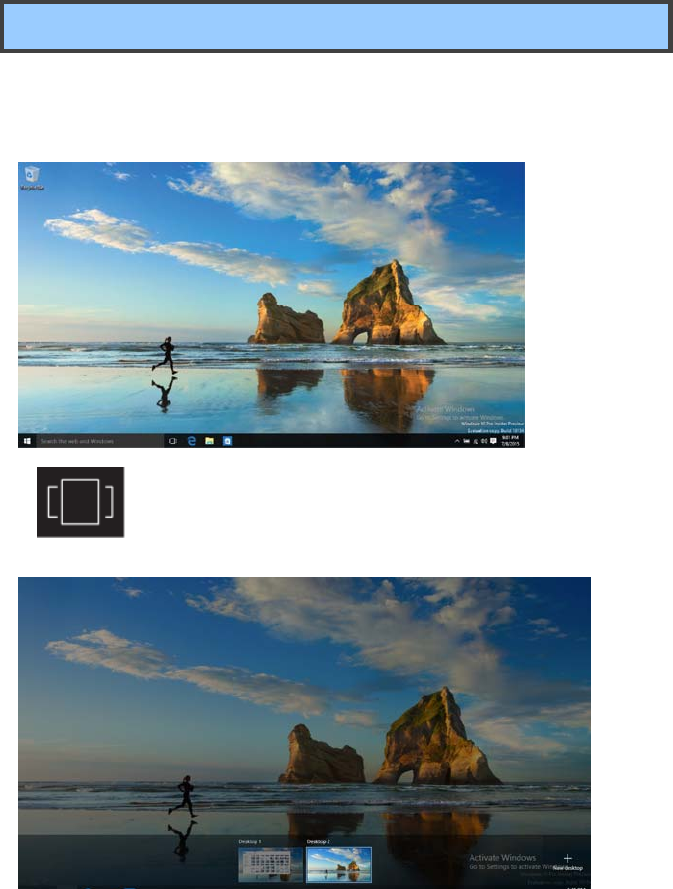
10
3. Windows
Interface
Desktop and virtual desktop experience
The Desktop screen is as shown below and natively provides virtual
desktop feature.
To launch the feature you can click the app icon as shown
on the left or just press Window key and TAB key of your
keyboard in the same time.
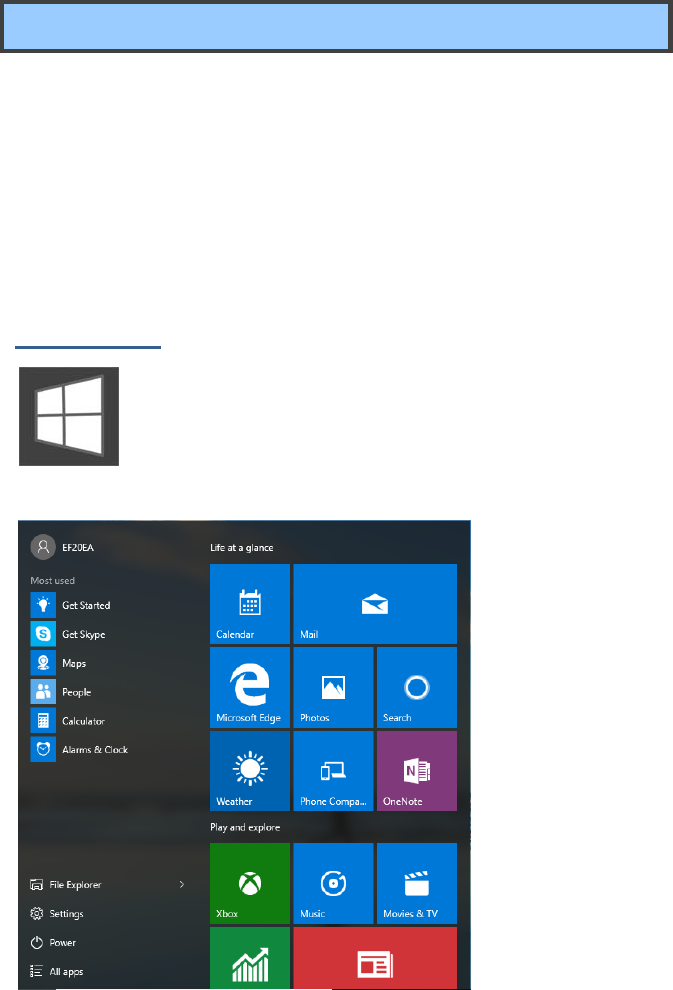
11
Taskbar
The black bar on the bottom of the desktop is called Taskbar. It provides
several key features and they are:
Start menu
Search box
App shortcuts area
Notification area
Start menu
To open the Start menu, you can either click on the
windows icon (which is also known as Start button) located
at the left end of the taskbar or press once on the windows
key of the keyboard. And the Start menu will appear, as shown below
For how to setup this menu, please refer to page17.
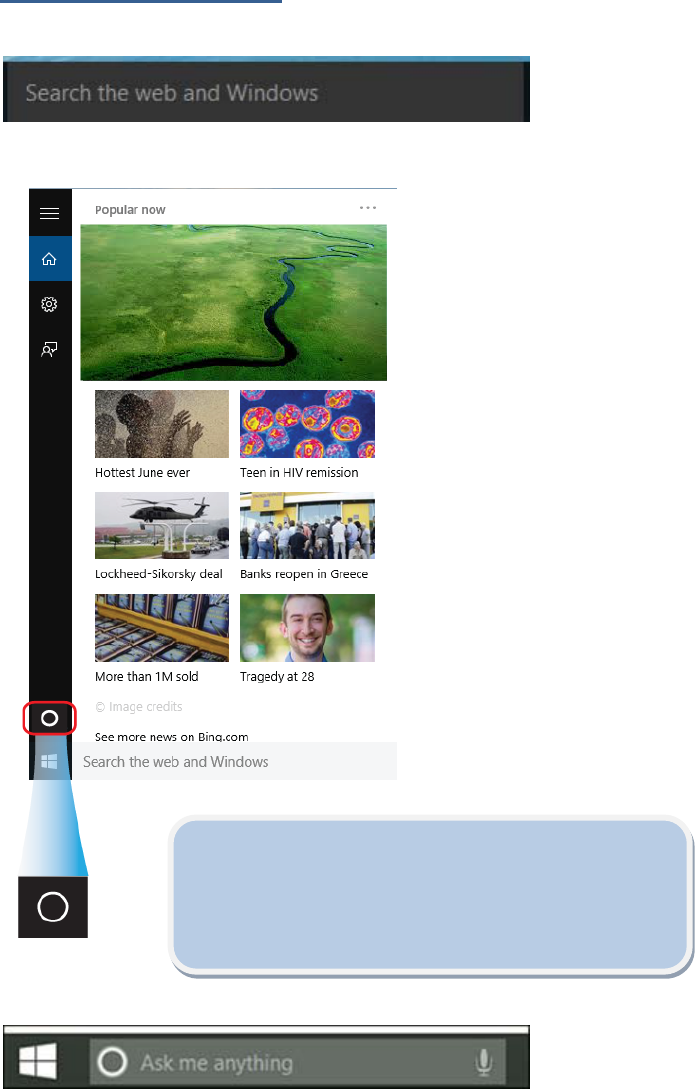
12
Search box - Cortana
Next to the Start menu is the search box, as shown below.
When you select this box, a window will pop out as shown below.
This is the Cortana icon. Cortana is a new virtual
assistant built into your Windows 10. Click here to
finish the setup and you can control Cortana with
either keyboard or voice commands, and use it to
perform intelligent searches and more.
After you setup the Cortana settings, the search box will look like
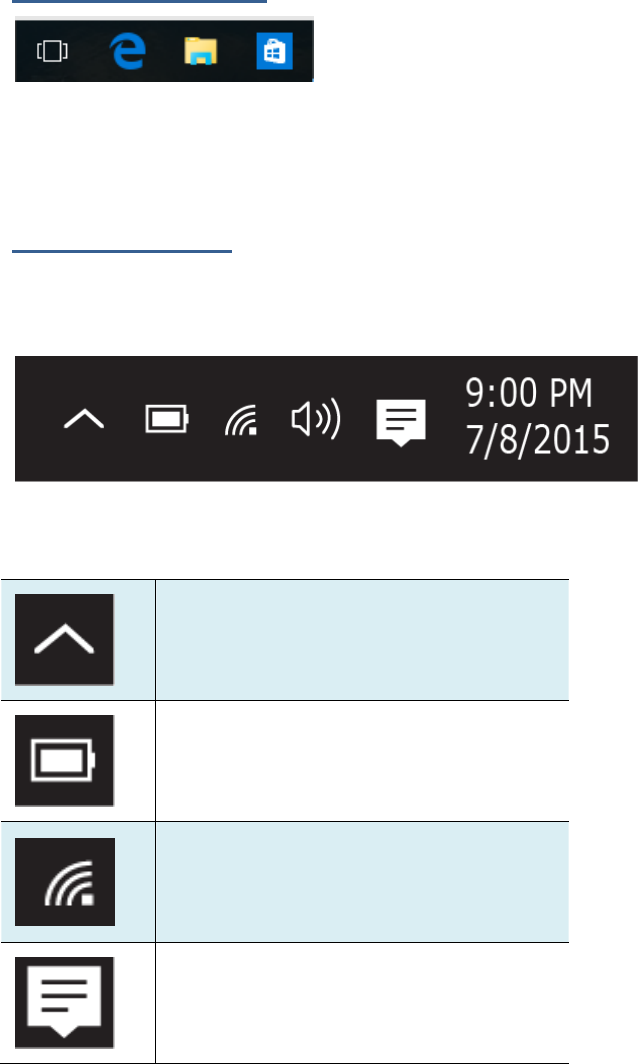
13
App shortcuts area
In this area, you can put the shortcuts of your frequently used apps. For
how to arrange this area, please refer to p.17
Notification area
The right part of the taskbar holds several icons that show you the status
of your laptop, as shown below.
This is an area called Notification Area, where
Click here to show more status icons.
Shows you the current battery status.(For
detail, please refer to page 23)
Shows you the status of your wireless
network connection.
Click here to show the unread notifications.
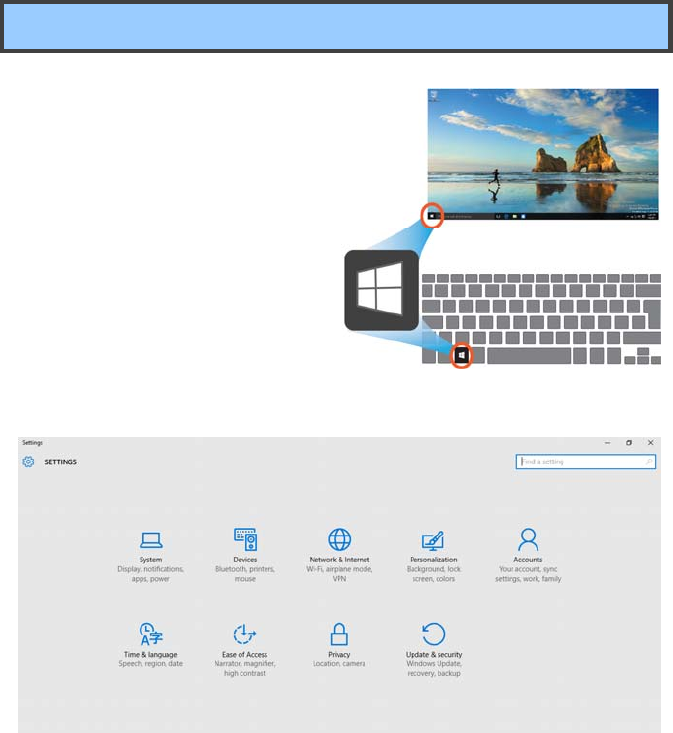
14
4. Setup and
Connection
Settings screen
To access to the Settings screen:
1. Click the Windows icon in the
low-left corner of the Desktop.
Or, press on the Windows
key in the keyboard.
2. Select <Settings>.
This will open the Settings screen, as shown below
.
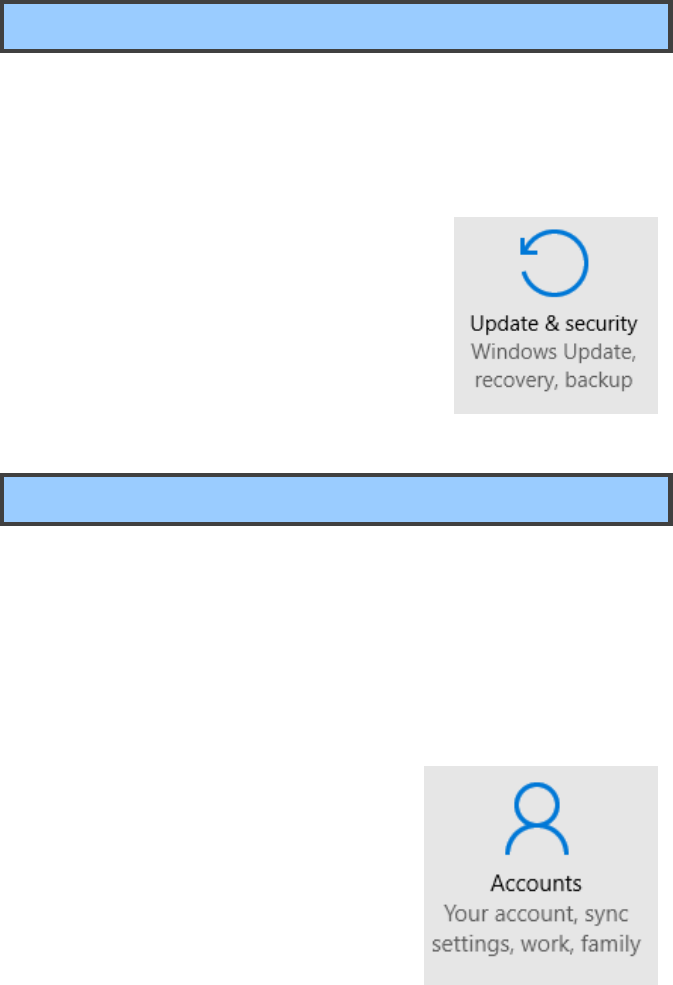
15
Windows Activation
To use all features of your Windows laptop, you may need to activate
your Windows system. Follow the following steps to register and activate
your Windows.
1. Open the Start menu and click <Settings >.
2. Click <Update & security>
3. Select <Activate>.
4. Follow the instructions to activate your
windows.
Setup Your Microsoft Account
To share files or settings with other devices running Windows 10, you
need to setup a Microsoft Account. Furthermore, if you want to download
or purchase apps from the Microsoft Store, such Microsoft Account is
required.
To setup your Microsoft account
1. Open the Settings screen and select
<Accounts> .
2. Select <Your account >
3. Select <Sign in with a Microsoft account
instead>.
4. Follow the instruction to register your
account information.
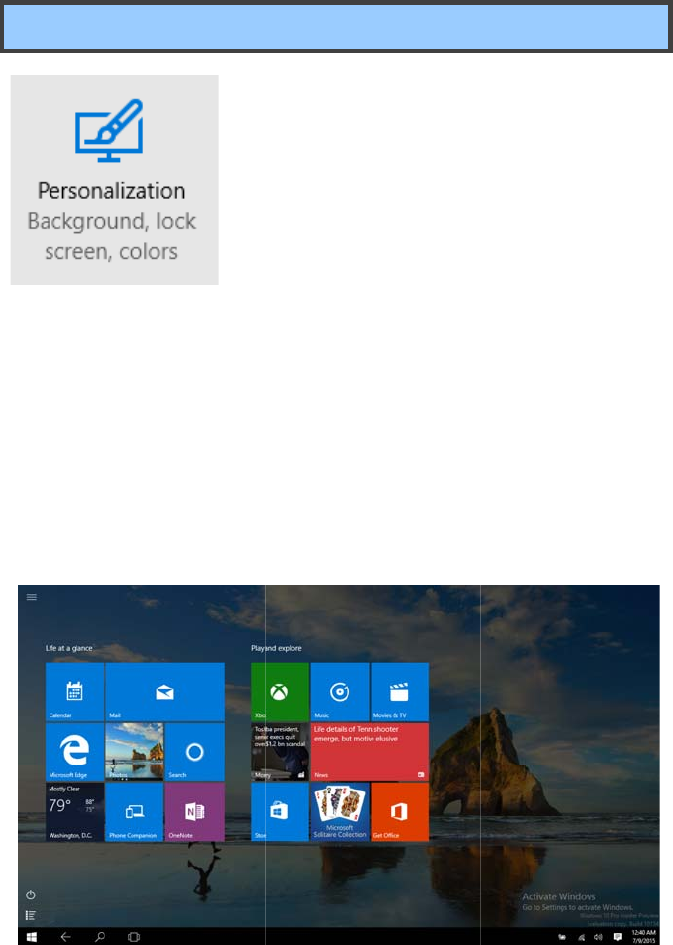
Re
1.
2.
3.
A
fte
you
r
placing
Open the S
e
Select <Per
s
In the Pers
o
screen>
r these step
s
r
laptop, as
s
Deskto
p
If y
o
to t
ser
St
a
wh
e
the
e
ttings scree
s
onalization
>
o
nalization s
c
s
, you will s
e
s
hown belo
w
16
p
with St
a
o
u are more
he Start scr
e
ies, you can
a
rt screen in
s
e
n you pow
e
following st
e
n.
>
.
c
reen, enabl
e
e
e the Start
s
w
.
a
rt scre
e
familiar with
e
en introduc
e
set your lap
s
tead of the
D
e
r on your la
p
e
ps:
e
the option
s
creen ever
y
e
n
the interfac
e
e
d in Windo
w
top to show
D
esktop eve
p
top.
T
o do
s
<Use Start f
u
y
time you tu
r
e
similar
w
s 8
the
ry time
s
o, do
u
ll
r
n on
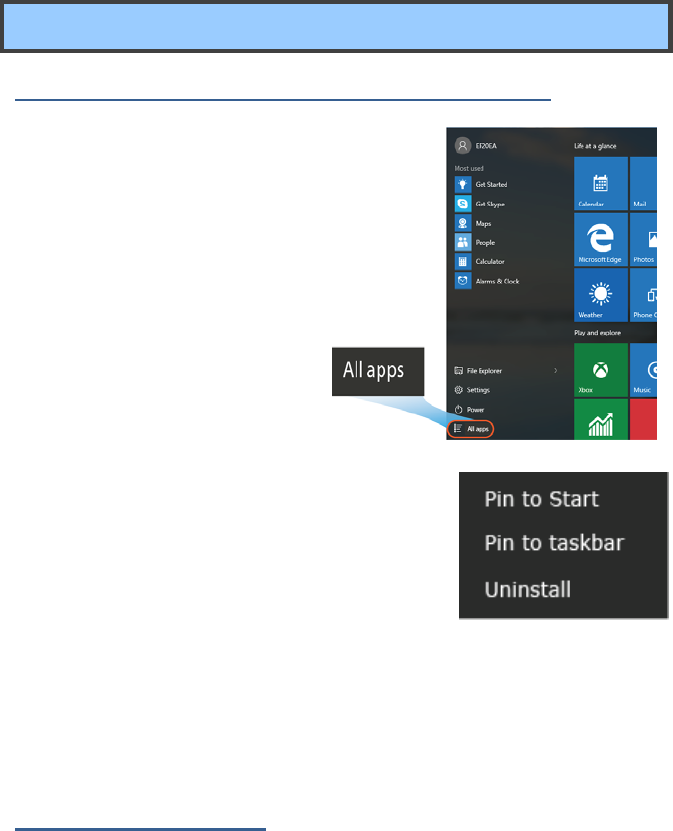
17
Pin and unpin your app
Pinning an App to Start menu or taskbar
To add an app:
1. Open the Start menu and
select <All Apps> .
2. Right-click on the app that you want to
appear on your Start menu or taskbar, and
an option menu appears.
3. Click <Pin to Start> or <Pin to taskbar>to add the app to your Start
menu or taskbar .
Removing an App
To remove an app:
1. Right click the app that you want to remove from your Start menu or
taskbar.
2. Click <Unpin from Start> or <Unpin from taskbar> to remove it from
your Start menu or taskbar.
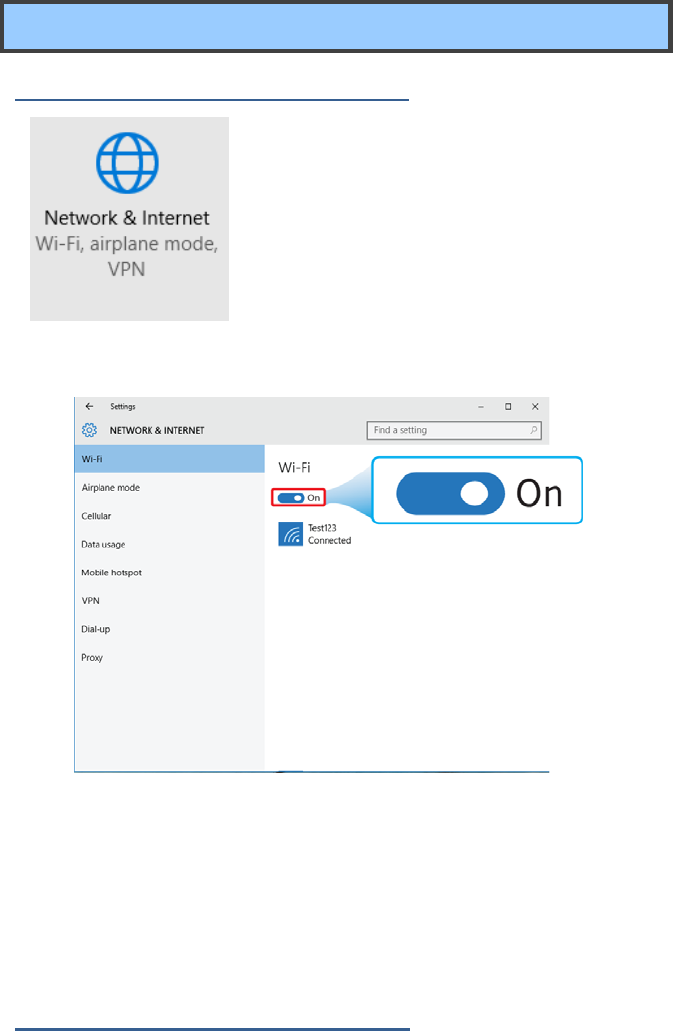
18
Wireless LAN
Enabling wireless connection
1. Open Settings menu and select
<Network & Internet>.
2. Select <Wi-Fi> and set the function to ON, as shown below
.
3. Make sure you have switched the Airplane mode off. To confirm that
Airplane mode is disabled, go to the desktop and check the
notification area. If you see an airplane icon displayed on the lower
right, press Fn+F10 to disable the Airplane mode.
Connecting to a wireless LAN
Once the wireless has been enabled, the computer automatically
scans for available wireless networks and displays them in the
wireless LAN network list. To connect to your desired wireless
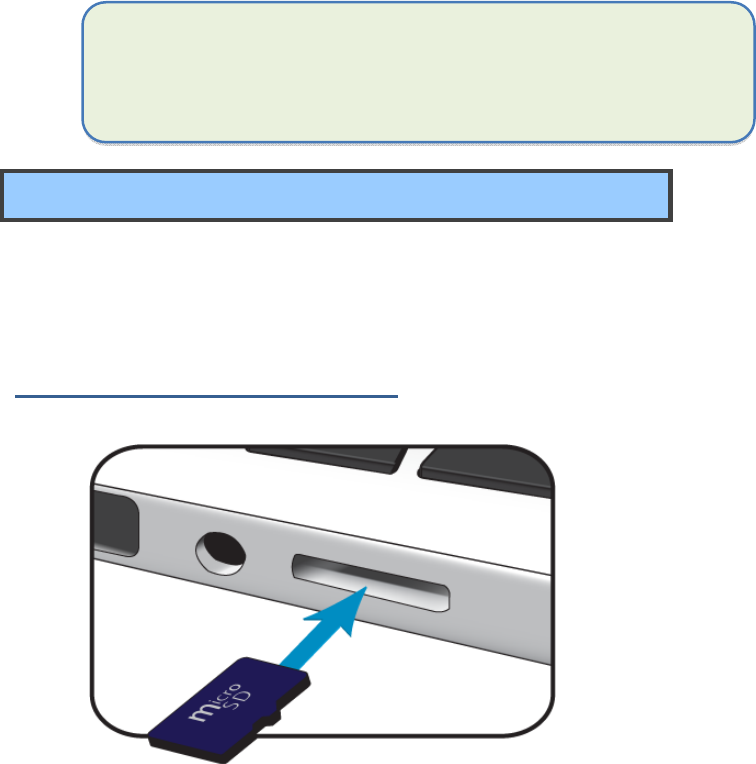
19
network, click the network’s name in the list, and then click
Connect.
Note: Some networks require a network security key or password for
connection. If necessary, ask the network administrator or the Internet
service provider (ISP) for the required information.
Micro SD Card Slot
You can utilize your micro SD cards as removable disks and conveniently
exchange data with digital devices such as a digital camera, digital
camcorder, MP3, etc.
To insert your micro SD card
1. Insert the micro SD card into the card slot as shown below.
2. Follow the message on the screen, and choose to open and view
files.
3. A Windows Explorer runs and shows all the folders and files in the
micro SD cards, and you can save, move and delete data as you are
handling a storage device.
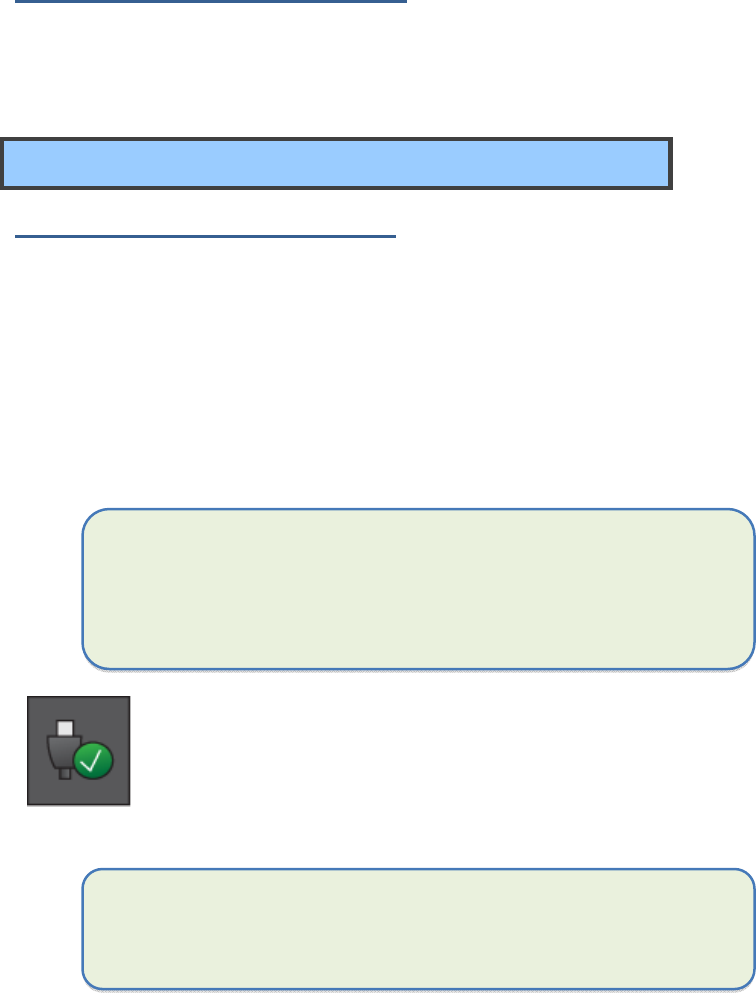
20
To remove your memory card
1. Press the card and release. The card will pop up.
2. Pull the card out by holding the end of the card.
Connecting an External Device
Connecting to the USB port
Your computer comes with one USB 2.0 port and one USB 3.0 port
compatible with USB devices.
Once you plug a USB device into a USB port on your computer, Windows
automatically loads a driver for that device. After the driver has been
loaded one time, you can disconnect and reconnect the same device
without performing any additional steps.
Note: If Windows requires you to install the driver before connecting,
check the documentation provided by the device’s manufacturer before
connecting the device.
To disconnect a USB storage device, make sure you click
the Safely Remove Hardware icon (as shown on the left)
in the notification area of the taskbar to remove the
device before disconnecting.
Note: If your USB device uses a power cord, connect the device to a
power source before connecting it.
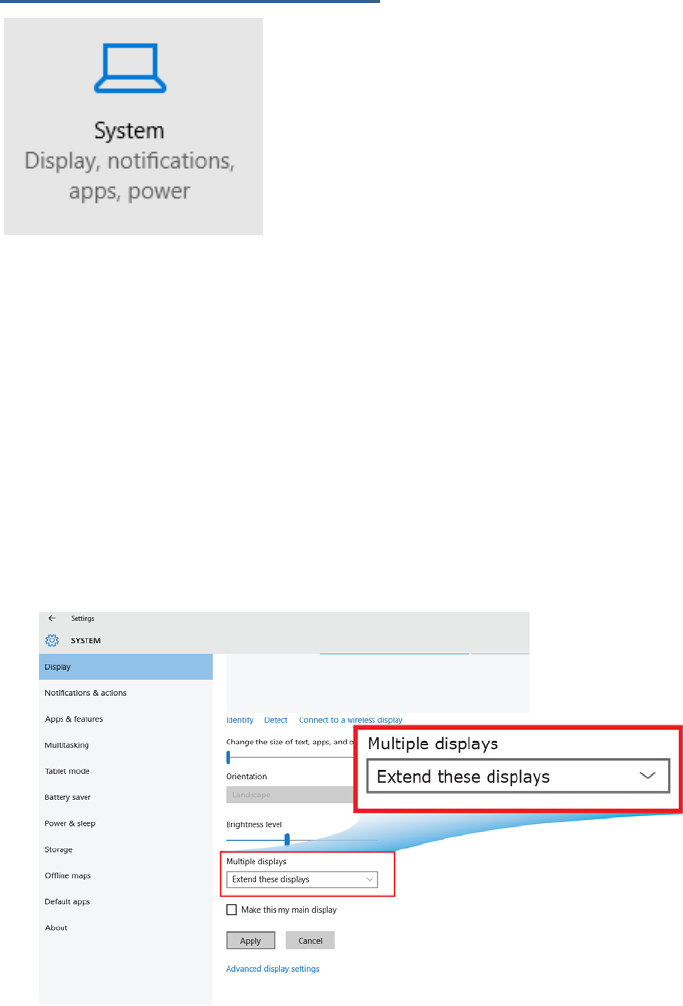
21
Connecting to the HDMI port
You can connect an external display
device such as a monitor, TV, projector,
etc., only if such device has a HDMI port.
By doing so, you have a wider view when
you give a presentation or watch a video
or movie.
1. Power off the external device.
2. Locate the HDMI port on your computer.
3. Connect one end of your HDMI cable to the port, and the other end
to the HDMI port on the external device.
4. Power on the external device.
When connecting a TV, you may need to configure your TV to
external device mode.
5. Open the Settings screen, select <System>and then <Display>.
6. Click <Multiple displays> to open the drop-down list.
7. From the list, select your desired monitor mode.
8. Click <Apply> and confirm your setting.
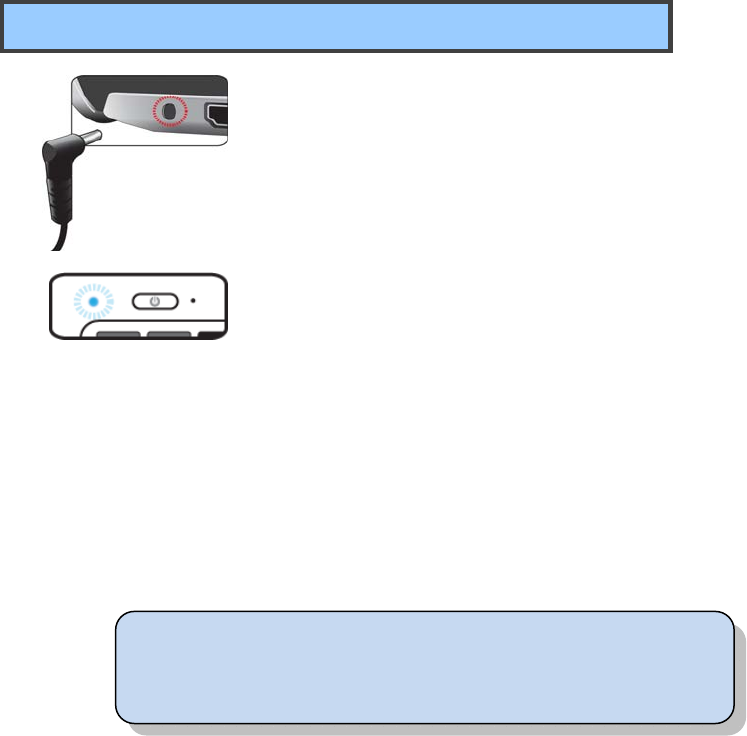
22
5. Battery
Charging your battery
1. Plug the adapter into the DC-in, which you
can find on the left side of your laptop.
2. Plug the adapter into a wall-socket.
3. You shall see the battery indicator starts
blinking in blue.
4. When the battery is fully charged, the battery indicator will stop
linking and stays solid in blue
While system is off, it takes around 3 hours to fully charge the battery.
After fully charged, the battery Life reaches 11hrs on full HD video
playback
Note: If the remaining power in your battery capacity is 90% or
above, plugging the adapter will not fully charge your battery.
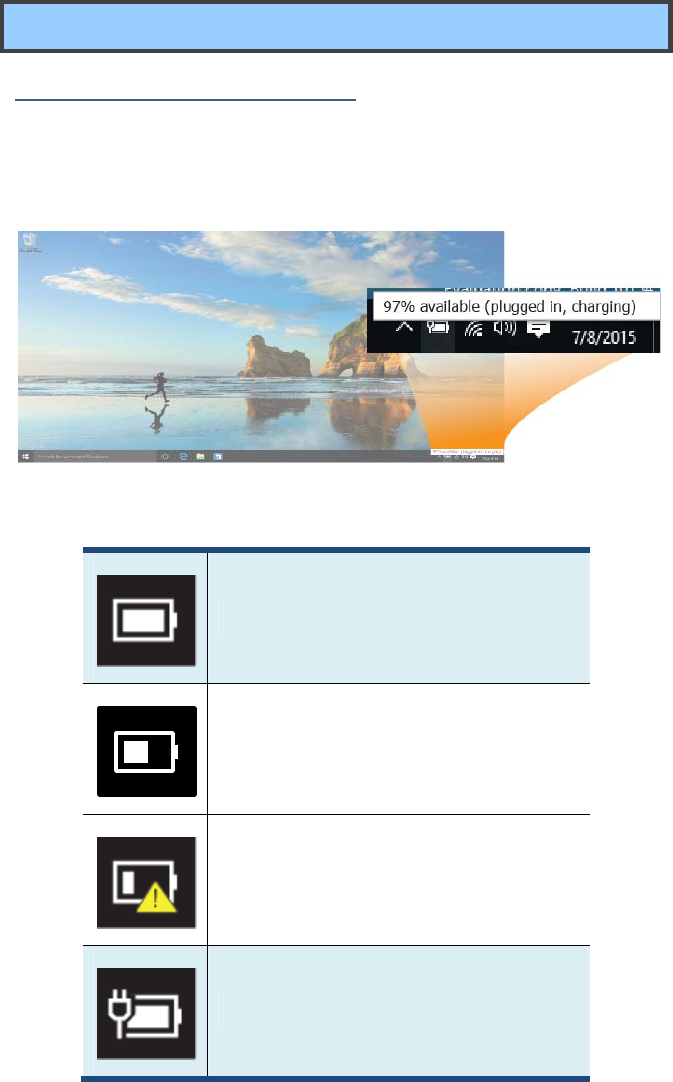
23
Inspecting your battery status
By inspecting the taskbar
In Desktop, move the cursor to the battery icon in the taskbar. A pop-up
dialog box appears and shows you the remaining battery percentage, as
shown below.
The battery icon reveals the status of your battery, which described
as below.
Battery is fully charged
Battery is starting to drain
Battery is about to completely
drain, and you should stop using your
computer and charge it at once.
Battery is being charged.

24
By inspecting the battery indicator
When your laptop is not powered by the adapter, the color of the battery
indicator shows you the approximate status of your battery.
Battery Low : Blinking in red
Battery High: Blue and Red LED off.
A battery is an expendable supply, so when using it over a long time, the
capacity/battery life is shortened. If the battery life is reduced to under
half of its initial time, we recommend purchasing a new battery.
When not using the battery for a long time, store the battery after
charging it to 30-40% of its capacity. This extends the battery life time.
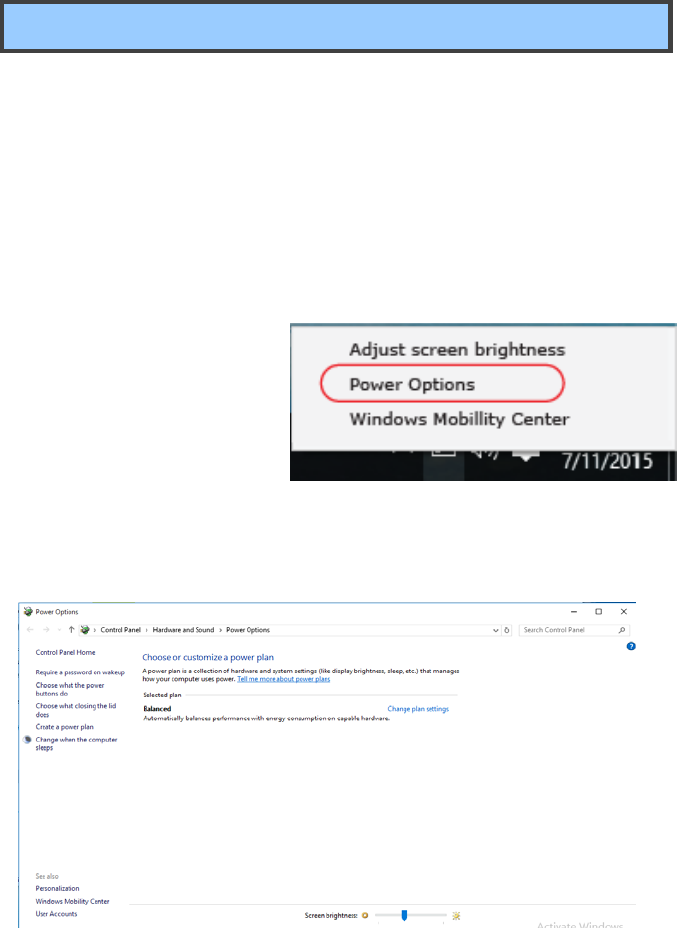
25
6. Windows Help and
Troubleshooting
Settings for Sleep mode
Your laptop is delivered with the factory settings. In the factory settings,
for example, the idle time before going into the sleep mode is set as
follows:
4 minutes ( for Battery mode) or
10 minutes (for Plugged-in mode).
If you want to change the
settings, just right click on
the battery level icon that
can be found on the taskbar,
and select <Power Options>
The setting page will be open as shown below..
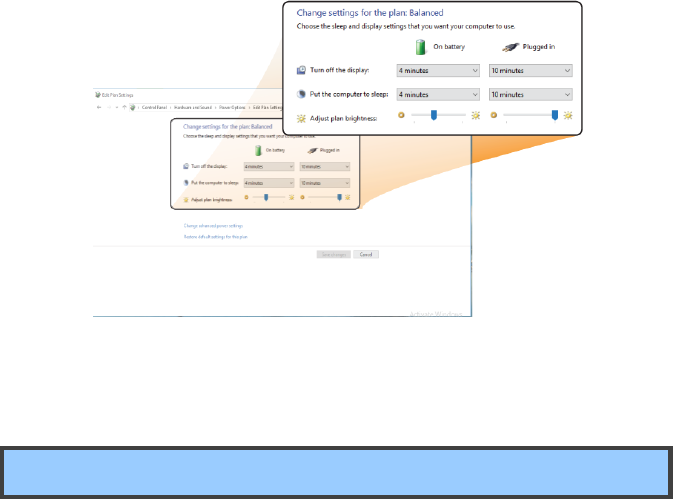
26
This page provides an option for you to edit your Power Plan settings. To
do this, simply click on the <When the computer sleeps>. Then, the
editing page will be displayed as shown below
After setting the waiting time, you need to press <Save changes> to
confirm your changes.
Troubleshooting
This section describes some common problems and suggested
solutions, and ways to recover your computer from a crash.
Be aware that the problems and solutions described here are meant
only as a guide. They are not definitive problem solving techniques.
For certain problems, you might need help from your reseller or your
service provider.
When you observe a problem, stop operation immediately, because
taking further action might result in data loss or damage. Take a note
of what the system is doing and what actions you performed before
the problem occurred. Provide detailed information to your service
provider for quicker problem resolution.

27
For about any problem, follow these steps:
1. Restart your laptop.
2. Check your Wi-Fi connection.
3. Reset your Wi-Fi connection.
4. Plug your laptop to a wall socket to charge it for at least one
hour.
Screen problems
When I turn on the
computer, nothing appears
on the screen.
• If the screen is blank, make sure that:
- The AC adapter is connected to the
computer and the power cord is plugged
into a working electrical outlet.
- The computer power is on. (Press the
power button 6 seconds to force the
power off, and power it on again.)
• If these items are properly set, and the
screen remains blank, have the computer
serviced.
My screen goes blank while
the computer is on.
• Your laptop is in its sleep mode. Do one
of the following to resume from sleep
mode:
- Press any key on the keyboard for 2 to 3
seconds.
- Press the power button.
- Press the windows key button.
Sleep problems

28
The critical low-battery error
message appears, and the
computer turns off
• The battery power is getting low.
Connect the AC adapter to the computer.
The computer enters sleep
mode immediately after
Power-on.
• Make sure that the battery is charged.
- The operating temperature may be too
hot. Move to a cooler environment and try
to wake the computer.
The computer does not
return from sleep mode and
the computer does not
work.
• If your computer is in sleep mode,
connect the AC adapter to the computer,
then press the key button or the power
button.
• If your computer is powered-off, connect
the AC adapter to the computer, then
press the power button to resume
operation.
Display problem
The screen is blank. • Do the following:
- If you are using the AC adapter, or using
the battery, and the battery status
indicator is on, press Fn+F4 to make the
screen brighter.
- Press the power button to resume from
sleep mode.
- If the problem persists, follow the
solution in the next problem “The screen
is unreadable or distorted.”

29
The screen is unreadable or
distorted.
• Make sure that:
- The screen resolution and color quality
are correctly set.
- The monitor type is correct.
Incorrect characters appear
on the screen.
• Are the operating system or programs
installed correctly? If they are installed
and configured correctly, have the
computer serviced.
Sound problems
No sound can be heard
from the speaker even
when the volume is turned
up.
• Make sure that:
- The Mute function is off.
- The combo audio jack is not being used.
- Speakers are selected as the playback
device.
Other problems
Your computer does not
respond.
• To turn off your computer, press and hold
the power button for 6 seconds or more. If
the computer still does not respond,
remove the AC adapter.
• Your computer might lock when it enters
sleep mode during a communication
operation. Disable the sleep timer when
you are working on the network.
The connected external
device does not work.
• Do not connect or disconnect any
external device cables other than USB
while the computer power is on.
Otherwise, you might damage your
computer.
• When using a high power consumption

30
external device such as an external USB
optical disk drive, use an external device
power adapter. Otherwise, the device may
not be recognized.
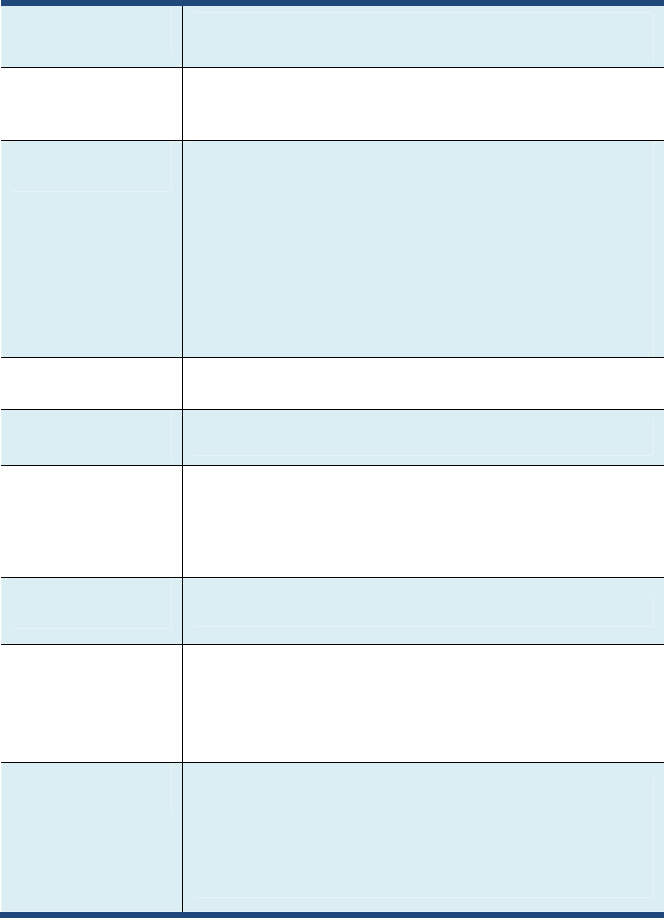
31
7. Specification
Processor Intel® Cherry Trail Type3
Z8300
Memory 2 GB
DDR3L one channel, 1600MT/s (max.)
Storage EMMC Module
32GB/ 64GB EMMC v4.51
eMMC Controller
HDD (WD/TOSHIBA)
SATA III, 7mm, 320G/500G
HDD Boot
Dimension 305 x 202 x 19.9 mm
Weight 1.3 kg
Wireless 802.11a/b/g/n dual-band radio
Bluetooth V4.0 and Low Energy (BLE)
support
LCD 11.6”TN 3.6mm 1366 x 768 ( w/o Touch)
Cameras Front facing camera: VGA 0.3M,D-MIC*2
(default)/ D-MIC*1 (optional)
Battery 2cell ,5000mAh with 2S1P
Model No.:
EF20-2S5000-G1A1
EF20-2S5000-S4L8
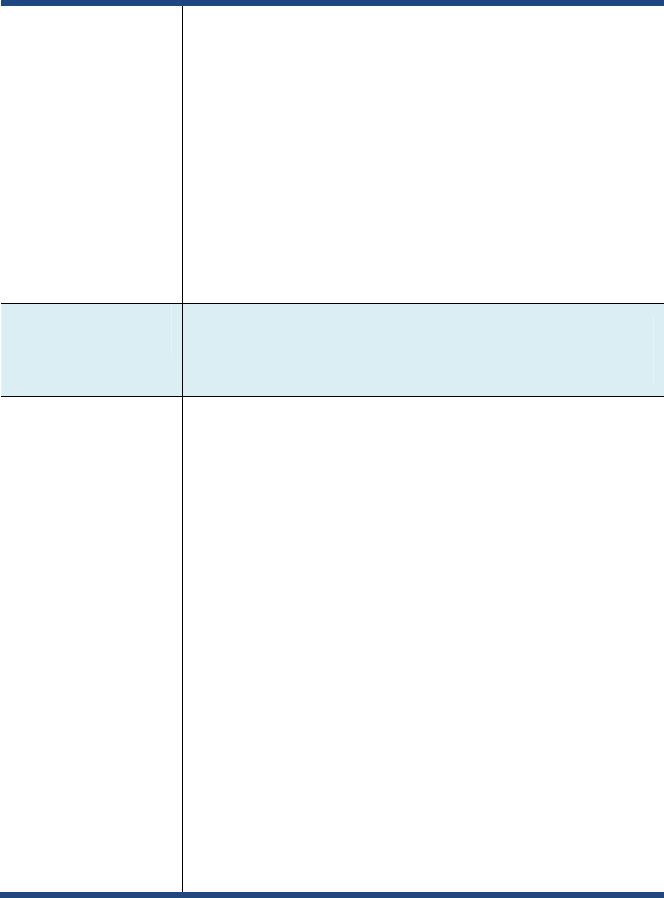
32
Input/Output 1 x Mini DC-in jack
1 x USB 2.0 port
1 x USB 3.0 port
Supports USB Charger Function
1x HDMI port
1x Micro SD Card slot
1 x combo Audio jack
1x Micro SIM Card slot (w/ 3G Optional)
Speaker Speaker :
Build-in 2 Speakers (1.1 W)
Language English
Spanish
Portuguese
Arabic
Turkish
Russian
Simplified Chinese
Thai
Greek
Hungarian
Traditional Chinese
German
Hebrew
Italian
Latin Spanish
Brazil Portuguese
French
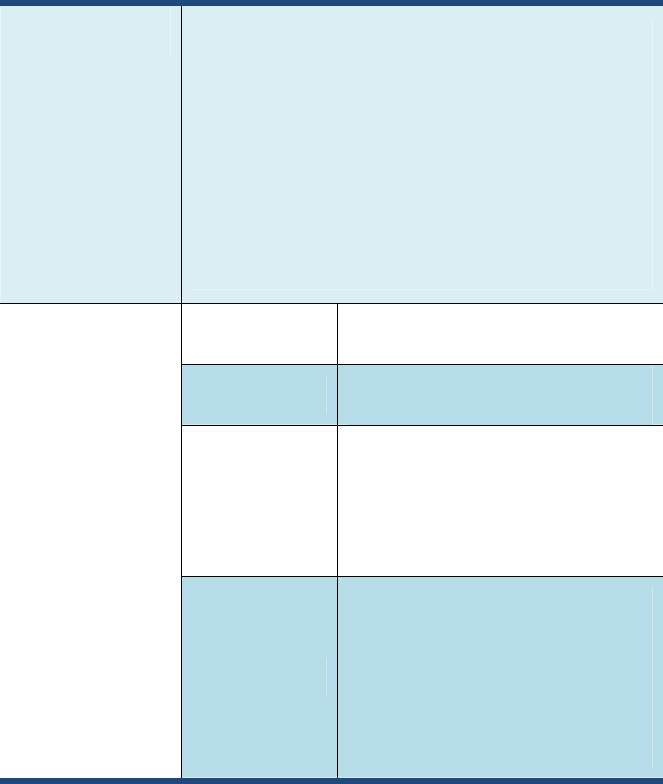
33
AC adapter DC Output: 12V/24W
Input Voltage: 100–240VAC Nominal
Input Frequency: 50–60Hz.
Model No.:
Asian WA-24Q12Fy, WA-24Q12R
(y=A,B,C,G,K,N, S, T, or U)
Kuantech KSASB024xxxyyyyVz
(xxx=090-240, yyyy=0001-0250,
z=A, C, E, I, K, O, R, B, or U)
Certification EMC CE
FCC
RF FCC&SAR / R&TTE
NCC
Safety&
Environment
UL / CB
CCC
CEL
WEEE
RoHS
Others
HDMI
Energy star 6.1 (Design
ready)
Erp Lot 6 (Design ready)
Drop test 50 cm
HDCP (Design Ready )